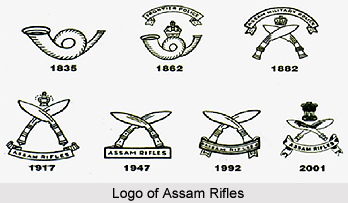 The regiment of Assam Rifles was one of the most prominent paramilitary police forces of the British East India Company. It was raised in 1835 as the Cachar Levy. The regiment was renamed several times and was finally designated as the Assam Rifles in 1917. The battalion served under the British Indian Army during the First World War and fought in the Middle East and Europe. The Assam Rifles also fought during the Second World War. After the War the regiment was developed and expanded. After the Indian independence, the army unit was assigned to the modern Indian army and became a part of the Indian Paramilitary Forces. At present, the unit consists of forty six battalions which are administered by the Indian Ministry of Home Affairs (MHA). The unit performs border security operations, provision of internal security under the Indian army and acts as provision of medical assistance, communications, and education in remote regions.
The regiment of Assam Rifles was one of the most prominent paramilitary police forces of the British East India Company. It was raised in 1835 as the Cachar Levy. The regiment was renamed several times and was finally designated as the Assam Rifles in 1917. The battalion served under the British Indian Army during the First World War and fought in the Middle East and Europe. The Assam Rifles also fought during the Second World War. After the War the regiment was developed and expanded. After the Indian independence, the army unit was assigned to the modern Indian army and became a part of the Indian Paramilitary Forces. At present, the unit consists of forty six battalions which are administered by the Indian Ministry of Home Affairs (MHA). The unit performs border security operations, provision of internal security under the Indian army and acts as provision of medical assistance, communications, and education in remote regions.
History of Assam Rifles
The Assam Rifles regiment was formed as the Cachar Levy by the British administration in the Assam region in 1835. It is the earliest paramilitary force in India. It was established as a police unit with 750 personnel. The Assam Rifles protected settlements against tribal and other invasions as the British East India Company advanced to the north east India. The unit was amalgamated into 3 battalions of the Assam Military Police. The 1st battalion was sent to Lushai Hills, the 2nd battalion was stationed in Lakhimpur and the 3rd battalion was posted in Naga Hills. Later the title and the roles of the regiment have changed several times. The Assam Rifles was later designated as the Assam Military Police.
Military Operations of Assam Rifles
The army regiment provided active service during the First World War. The troops served in the Middle East and Europe as part of the Indian forces. The men of the unit were later merged with the Gurkha regiments of the British Indian army. The Assam Rifles was honoured with 76 gallantry awards, including 5 Indian Distinguished Service Medals and 7 Indian Order of Merit awards. Due to the valuable services provided by the regiment, it was designated as the Assam Rifles in 1917 as recognition of their service.
After the culmination of the Great War, the regiment went back to British India and was stationed in northern India. The troops maintained security during the civil unrest. In year 1924 the Assam Rifles was posted in Malabar in Madras Presidency to fight against the Mopla insurgents. Later during the outbreak of the Second World War, the troops provide various services and performed as both a police unit and military unit. The Assam Rifles participated in the Burma Campaign. During the war, the men of the unit were honoured with 48 gallantry awards, including 7 British Empire Medals, 15 Indian Distinguished Service Medals, 13 Military Medals, 1 Indian Order of Merit, 4 Order of British India medals, 5 Military Crosses and 3 Member of the Most Excellent Order of the British Empire (MBE).
Development of Assam Rifles
After the end of the Second World War, the 5 battalions of the Assam Rifles were incorporated as a part of the civil police under the Assam Inspector General of Police. After the nation achieved independence from the British Empire in India, the country was divided into the Union of India and the Dominion of Pakistan. The Assam Rifles was allotted to the modern Indian Army and was assigned its own Director General.



















